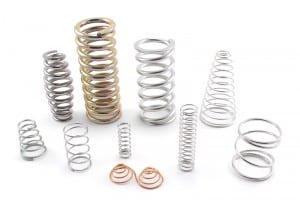
Springs are incredibly common components that are used in nearly every industry. Because they are an essential part in so many applications, they are subjected to heavy use and wear. Having access to replacement springs or having parts on hand is not only a good idea but may be necessary to prevent shutdowns in any operations. Perhaps just as necessary as knowing how to tell when springs need to be replaced before they snap, break or stretch out and lose their ability to store potential energy.
What Are the Most Common Types of Springs?
The most common types of springs are compression, extension, torsion and leaf springs. The first three are helical and most often made of metal. Leaf springs are bowed or elliptical, and they too are often made of metal. As their names imply, compression and extension springs describe their mechanical application, i.e., how they store potential energy. They function when compressed (like a pogo stick) or extended (like when shutting a garage door). Torsion springs are tightly wound except for their ends, i.e., the legs, which extend out at a ninety-degree angle from each other. Potential energy is stored by twisting, creating torque through rotation (as in a mousetrap) of the legs to a hundred-eighty degree angle. Leaf springs are long metal strips used to supply suspension (as in a carriage). All springs eventually wear out. They undergo gradual relaxation called spring creep and have to be replaced. Here are some tell-tale signs to know when you may need to replace your springs:
Compression Springs
Compression springs are those coiled springs that absorb shock or maintain a force between two objects or surfaces. The yield strength of a coil, i.e., the amount of stress it can take when compressed, will weaken over time. Compression springs are often placed in a hole or pocket or over a shaft. The first sign of wear is when the spring loses its ability to fully return back from its compressed state. The coil’s outer diameter expands when a load is placed on it, and the coils, though compressed, do not touch. If they are touching or the spring is not returning to its original length, it’s time to replace the spring.
Extension Springs
Conversely, when an extension spring has worn out it will remain distended. Extension springs’ energy is in its extreme tension. The outer diameter of the spring shrinks as it is pulled apart. If the coils or part of the coil remains stretched or irregular when the spring is returned to its preloaded position, then it needs to be replaced.
Torsion Springs
A torsion spring’s potential energy is similar to that of an extension spring in that the outer diameter of the spring decreases as it is rotated to the loading position. Like all springs, torsion springs lose power and become weaker over time. Because it works by rotation and exerting force, torsion springs are prone to surface defects, causing it to weaken, resulting in less force exerted with each cycle. Rust is a torsion spring’s prime surface defect. Wear in the coils such as nicks or marks, or the legs bending are also signs that the lifespan of the spring is winding down, and it needs to be replaced.
Leaf Springs
Leaf springs are not coiled and were developed in the modern era to provide a suspension mechanism for carts and carriages initially, and then vehicles of all kinds. They have been used to carry the load of cars, vans, SUVs, buses or trucks. Found on the front or rear end, they are the slightly elliptical, strips of stacked steel on either end of the axle. Today, they are especially an integral part of the suspension systems of buses and trucks. If your vehicle sways or is bouncy after it hits a bump, or if the back end is sagging when carrying a load, you should have the leaf springs checked. Look for any cracks, excessive rust, broken, or missing pieces. If any of these signs are there, it is recommended to replace them as soon as possible.
Check out our selection of springs for all your replacement needs! Have questions or need guidance on replacement springs? Feel free to contact us online today to speak with a member of our experienced team.

